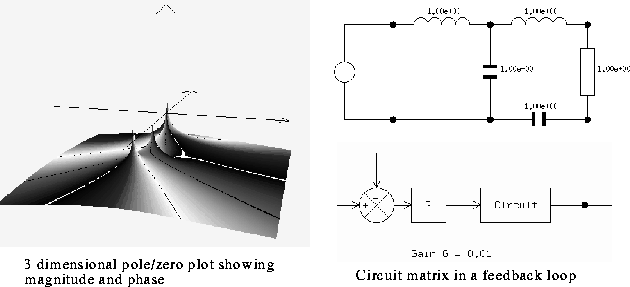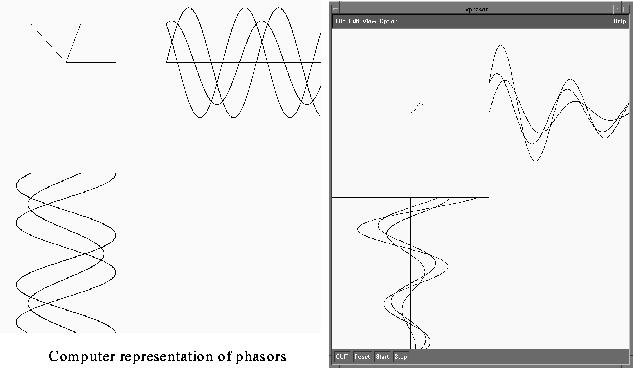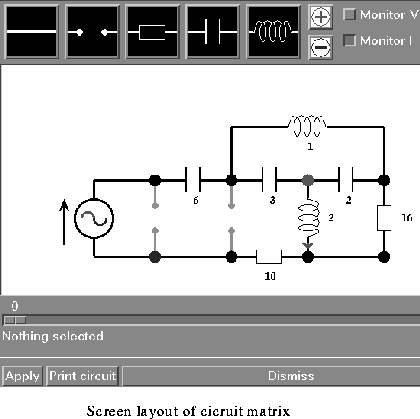Table of Contents
Alec Close
Heriot-Watt University
Edinburgh
To the list of Colos applications
Phasor is a set of applications which enable the user to interactively build up an understanding of phasors and their uses in a wide range of electrical engineering areas. The presentation links the phasor and the time domain picture dynamically, allowing parameter changes to be explored. The use of multiple phasors allows both frequency and time domain illustrations to be displayed and ultimately complex frequency signals to be introduced.
Phasor introduces simple concepts such as magnitude, frequency and phase in a dynamic and interactive way. Building up a set of phasors having identical frequency enables the user to understand sinusoidal addition and relative phase. If phasors of different frequencies are included the user is introduced to Fourier series and periodic waveforms. The dynamics of the application allows a time domain picture to be drawn with the phasor rotation and a separate window gives a frequency domain view. Phasor can be dynamically linked to the input of a linear circuit matrix consisting of resistance, inductance and capacitance, and a second version of phasor can be used to illustrate the output of the circuit to show interactively the effect of various circuit components. If a time variation of magnitude is included in phasor, then complex frequency can be generated, having all the previous features of phasor but now including exponential growth or decay. When this is applied to a circuit the concept of poles and zeros in the response is illustrated. If an array of complex phasors is used, a 3 dimensional picture of poles/zeros and phase response is able to be displayed illustrating root locus.

Exponentially decaying sinusoids (sigma + jw)

The traditional approach begins with the mathematics of the phenomena and there is therefore a long time gap between the simple phasor and understanding root locus. The approach taken by phasor shortens this time-gap by eliminating, at this stage, the need to first have mastered the mathematics required. The dynamics of phasor cannot be represented easily in a book and certainly the interaction is missing from a book. The didactical approach is to illustrate the concepts and encourage understanding through interaction before requiring the mathematics which will eventually be necessary for complete comprehension.
Phasor presents the user with a complete range of variables but although these are already built-in, it is not necessary for the user to be aware of this initially. On first use only a single phasor is presented with only magnitude, frequency and phasor being variable. Both sine and cosine time domain pictures are shown. When more than one phasor is introduced the student is first allowed to add phasors of identical frequencies before being faced with phasors of different frequencies. Some pre-prepared series of phasors are inbuilt to illustrate square waves for example. Using phasor with a circuit can be introduced at any stage, the simplest being a single frequency signal. The circuit components are `ideal' and are used to explore the relationship of current and voltage in R L or C.
Complex frequency appears as an exponentially varying sinusoidal signal.
When phasors, simple or complex, are used in combination to form periodic signals, then it is necessary to calculate and display the result of each individual sinusoidal upon being acted upon by a circuit to enable the maximum user interaction. This necessitates the use of a workstation powerful enough to be able to calculate and display in a time which appears to the user as `real time'.

Phasor requires to have a hypermedia shell written round it to be able to give the user the correct level of access appropriate to the stage of learning at the time.
The first target group is the teacher as in this mode the hypermedia shell is unnecessary. Once the hypermedia shell is in place students would be able to be placed on a directed course of study in this area. Some of the basic concepts are suitable for school level but in general phasor has been designed to be used by university students. Video taping from phasor is possible but careful design of the sequence would be required as this media loses the interactivity that using the workstation gives.
Some early evaluation of phasor concepts has been piloted with first year university students with favourable comments but a more full evaluation is necessary. This will be tied together with the hypermedia shell in order to be able to evaluate the use with students directly rather than simply in a lecture situation. The idea of an electronic book would also be valuable as a means of promoting the understanding of concepts explored by phasor.
